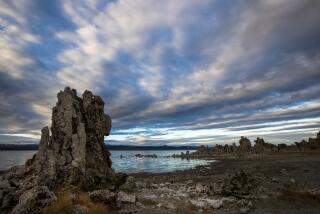Once teetering, Mono Lake is revived by heavy rains, snow

Recent storms and increased snowpack have contributed to rising water levels at Mono Lake. (Brian van der Brug / Los Angeles Times)
Reporting from Mono Lake, Calif. â Less than two weeks ago, hydrologists worried that it would take a wetter than average winter to keep this drought-stricken body of salt water at a level high enough to avoid having to halt diversions of its Sierra Nevada snowmelt to Los Angeles.
If the level drops below 6,377 feet above sea level, the city cannot export water from here. The California State Water Resources Control Board established the limit in 1994 to resolve ending a dispute between environmentalists seeking to protect the lakeâs wildlife and the city 350 miles away defending its long-held water rights.
Prospects for averting the crisis brightened significantly over the weekend after the third in a series of weather events that have drenched the slopes surrounding this high desert lake east of Yosemite National Park with enough rain and snow to raise its level by at least six inches, experts said on Monday.
Striding along a boardwalk with panoramic views of the lake famous for its craggy tufa formations and one of Californiaâs longest-running environmental dilemmas, Geoffrey McQuilkin, executive director of the Mono Lake Committee, a nonprofit group organized to save and protect the bowl-shaped ecosystem, said, âThe worst-case scenario is probably not going to happen.â
âWe expect this lakeâs level to rise by about 6 inches due to precipitation dropped from the past few storms alone,â he said. âThatâs a fast rise, and a lot of water.â
Richard Harasick, director of the Los Angeles Department of Water and Powerâs water system, would not argue with any of that.
âWeâre monitoring the impacts of the storm events on rising lake levels,â he said, âand things look promising at this point for all of us.â
Water from four of Mono Lakeâs five tributary streams has been going to the congested subdivisions surrounding Los Angeles since 1941.
By the late 1970s, the environmental degradation in the region was evident. Tributary streams dried up, lowering the lake level by more than 40 vertical feet. The water had doubled in salinity, leaving behind smelly salt flats scoured by choking dust storms.
The increasingly salty water threatened to kill brine shrimp, a favorite food of the estimated 50,000 California gulls that breed here each year. Exposure of a land bridge provided coyotes with access to the second-largest California gull colony in the state.
In 1983, the U.S. Supreme Court let stand a California Supreme Court ruling that environmentalists have the right to challenge the amount of water that Los Angeles imports from tributaries of Mono Lake. The California State Water Resources Control Board later ordered minimum flows restored for all diverted streams, while still allowing the agency to divert some water for consumption in Los Angeles.
Mono Lake was 6,377.33 feet above sea level in October, and it seemed unlikely that the region would receive a significant amount of rain by April, when official water level measurements are taken.
Not anymore. âThese weather events have put us all on a different track,â McQuikin said. âWho knows what the rest of the winter will bring?â
In the meantime, portions of the exposed land bridge to California gull nesting grounds on Negit Island and nearby islets are once again submerged, leaving the eggs and chicks a little less vulnerable.
ALSO
California winter storm live updates
An iconic California tree becomes a casualty of this weekâs storm
More to Read
Sign up for Essential California
The most important California stories and recommendations in your inbox every morning.
You may occasionally receive promotional content from the Los Angeles Times.









